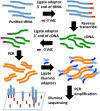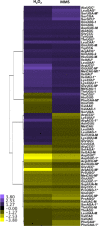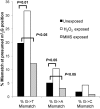Diverse cell stresses induce unique patterns of tRNA up- and down-regulation: tRNA-seq for quantifying changes in tRNA copy number
- PMID: 25348403
- PMCID: PMC4267671
- DOI: 10.1093/nar/gku945
Diverse cell stresses induce unique patterns of tRNA up- and down-regulation: tRNA-seq for quantifying changes in tRNA copy number
Abstract
Emerging evidence points to roles for tRNA modifications and tRNA abundance in cellular stress responses. While isolated instances of stress-induced tRNA degradation have been reported, we sought to assess the effects of stress on tRNA levels at a systems level. To this end, we developed a next-generation sequencing method that exploits the paucity of ribonucleoside modifications at the 3'-end of tRNAs to quantify changes in all cellular tRNA molecules. Application of this tRNA-seq method to Saccharomyces cerevisiae identified all 76 expressed unique tRNA species out of 295 coded in the yeast genome, including all isoacceptor variants, with highly precise relative (fold-change) quantification of tRNAs. In studies of stress-induced changes in tRNA levels, we found that oxidation (H2O2) and alkylation (methylmethane sulfonate, MMS) stresses induced nearly identical patterns of up- and down-regulation for 58 tRNAs. However, 18 tRNAs showed opposing changes for the stresses, which parallels our observation of signature reprogramming of tRNA modifications caused by H2O2 and MMS. Further, stress-induced degradation was limited to only a small proportion of a few tRNA species. With tRNA-seq applicable to any organism, these results suggest that translational control of stress response involves a contribution from tRNA abundance.
© The Author(s) 2014. Published by Oxford University Press on behalf of Nucleic Acids Research.
Figures




References
-
- Thompson D.M., Parker R. Stressing out over tRNA cleavage. Cell. 2009;138:215–219. - PubMed
Publication types
MeSH terms
Substances
Grants and funding
LinkOut - more resources
Full Text Sources
Other Literature Sources
Molecular Biology Databases

